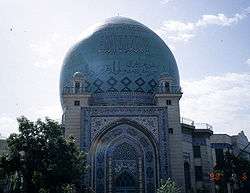Hosseiniyeh Ershad
The Hosseinieh Ershad or Hosseiniyeh Ershad (Persian: حسینیه ارشاد) is a non-traditionalist religious institute established by Nasser Minachi in Tehran, Iran.[1] It was closed for a time by the Pahlavi government in 1972. The institute is housed in a large, domed hall, and is used for lectures on history, culture, society, and religion. The facility also includes a large public library, where most of its users are college students.

The main facade of the center, facing Shariati Ave.
Ali Shariati held his anti-Pahlavi speeches here before the revolution. Mir-Hossein Mousavi (under the pseudonym Hossein Rah'jo) and Zahra Rahnavard exhibited artwork here during the same period.[2]
Public speakers
- Ali Shariati
- Morteza Motahari
- Fakhreddin Hejazi
- Reza Esfahani
gollark: Anyway, the boot media and storage are the same thing mostly.
gollark: There's no built in one, no.
gollark: Either a USB stick or microSD card.
gollark: You will need boot media.
gollark: You can get away with a high power tablet charger or something.
See also
References
- Gholam Reza Afkhami (2008). The Life and Times of the Shah. University of California Press. p. 445. ISBN 978-0-520-94216-5.
- Alavi, Nasrin (2 June 2009). "Iran: a blind leap of faith". Open Democracy. Archived from the original on 1 July 2011. Retrieved 14 July 2011.
This article is issued from Wikipedia. The text is licensed under Creative Commons - Attribution - Sharealike. Additional terms may apply for the media files.